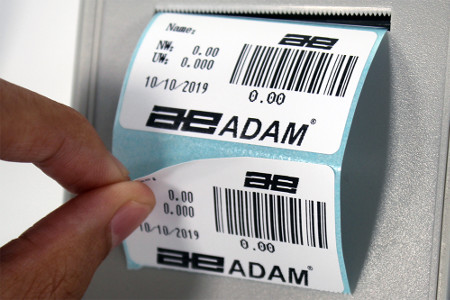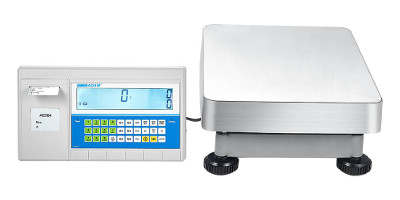
You can connect various peripherals to scales and balances but sometimes, scales have the printer integrated in the indicator for convenience. Should you get a scale with a built-in label printer? What are the benefits? Are there drawbacks?
This blog post will look at the benefits of label-printing scales and indicators. These scales print labels on sticky paper, which can then be placed on products or packaging. They do not print receipts or records unless they are connected to a separate paper printer.
Label-Printing Scales for Packaging
A built-in label printer is very useful for any kind of packaging task. Since the printer is directly connected, there is almost no chance of errors or transcription mistakes because the weight and quantities recorded are taken directly from the scale. The weighing and printing stations can be at the same location or separated by placing the indicator and the platform where you need them (as long as they remain connected), so you can reduce time and distance and allow staff to place labels on the products more quickly. It’s much more efficient and does not depend on multiple peripherals working together. Altogether, it saves space (particularly in smaller businesses) and helps people be more productive.
It can also be very useful for small businesses to get multiple applications in a single product, and they can create labels without going through costly third parties.

Users can also buy materials and goods in bulk and repackage them in smaller quantities and use the label-printing scale to label the smaller packages. That can be useful for businesses getting rid of surplus or looking to sell a raw product directly (for example, a coffee shop could sell their coffee or tea in small bags for customers looking to replicate their coffee at home). It can also be helpful for managing quantities of frequently used materials (like fertilizer or animal food) into more manageable portions.
Reduce Errors
The printer uses results obtained from the scale without any third-party software in the way. If the scale is accurate, so is the weight on the label. There is no need to write or record anything manually.
Shipping and Receiving
A scale with a built-in label printer can be useful for shipping and receiving various products, or for tracking products within a warehouse for inventory management. You can weigh and print the label directly or place the indicator on a station where the packages get scanned, labeled, taped, or placed in vehicles. Labels with barcodes can also be used for tracing products and packages. This is particularly useful to integrate the scale into various processes and systems that simplify tracking.
Stock control is also easier, since staff can quickly check the contents of bins and other containers and affix updated labels periodically. It saves a lot of time, especially for small pieces, and can help you track usage to make sure you're always stocked up on what you need.

Shops
While these scales and indicators are not trade approved, labels can be printed for goods that are not sold by weight, such as containers, hairbrushes, or clothing, as well as counting and labeling packages containing multiple items. Some food items also not sold by weight in containers, such as pastries, can also be labeled. It can be helpful for small and home-based businesses since you get the software, scale and label printer all together without having to spend time learning how to use multiple systems. Please note that if you’re selling anything by weight, you are legally obligated to use a trade approved scale.
Save Time and Money
With an ordinary scale, you would have to purchase software and a label printer separately, make sure everything is compatible and that there are no communication issues, and connect everything to the scale. That can take time and money, and there are no guarantees all the equipment will be compatible or work well every day. Integration can also be more difficult when juggling multiple systems and machines. It also means that if, say, the printer breaks down or the software has an issue, the rest of the equipment is on standby until everything can be connected again. A scale or indicator with a built-in printer removes these headaches and ensures seamless integration. Both our label printing indicators feature an RS-232 connection to connect to computers for using the software and integrating to various inventory management systems without having to concern yourself with printer drivers or compatibility issues.
Custom Labels
Our software allows users to create custom labels with barcodes, QR codes, pictures, and logos to the 50mm-wide printed labels, in addition to prices, quantities, product name and any other information you might need. That means that whenever you rebrand, launch new products, or just want to switch from your old label printer and scale setup to one of our products, you can design your own labels in-house without any delay or needing to give access to your files.
The software is quick and easy to use, so you can make sure the labels feature all the information your staff and customers need. That’s helpful for establishing strong branding guidelines and can be useful in situations where labels need information in multiple languages, flash sales where you want to mark discounted products or if customers want specific information on labels (like nutritional content, ingredients, or the date). Custom labels are also well-suited for businesses with varying inventory like artisanal crafts or seasonal goods, since they can be created and adjusted on the fly.

Flexible Configuration
Our BKT label printing scales and BCT advanced label printing scales include small and large stainless-steel platforms that can be used as weighing and labeling stations. If you need a larger platform, combine an AE 503 label printing indicator or AE 504 advanced label printing indicator with one of our platforms, like a PT or a WL. The indicators can be mounted on a pillar like they are on the scales, or on a wall or bracket to see the indicator from afar or move the products through a conveyor system before affixing labels.
Differences Between AE 503 and AE 504 Indicators
You’ve decided on getting a label printing scale, but which option is right for you? We offer two indicator models with various features and functions. Why is the 504 the “advanced” version?
The AE 504 advanced label printing indicator offers 1006 PLUs for quickly storing and recalling products, which is very useful for large inventories. The display also shows weight, unit weight and the count. The AE 504’s full numeric keypad allows speedy sample entry and more flexibility when operating the indicator. If you have a large inventory, frequently need to use the indicator’s keypad and count large quantities of small components, you should consider the AE 504 or the BCT scale. The AE 504 also includes PLU software so you can take advantage of the RS-232 connectivity and set your product values through a computer to save time.
Both indicators share most features. The AE 503 is also capable of counting, checkweighing and printing labels, and offers the same rugged construction, zero tracking and piece weight refinement. The keypad is smaller, so the AE 503 and BKT are recommended for checkweighing or more basic counting tasks in packaging and industrial plants. Since the AE 503 only displays one result at a time (instead of weight, count and unit weight), the digits are displayed in 1.3-inch/34mm-tall as opposed to the 0.9-inch/22mm-tall digits of the AE 504.

Please note that neither of these products are trade approved, and they should not be used in retail applications.
We hope this guide was helpful and that you understand the benefits of using label-printing scales and indicators. If you have more questions about our products, feel free to contact us. We’re happy to help!

